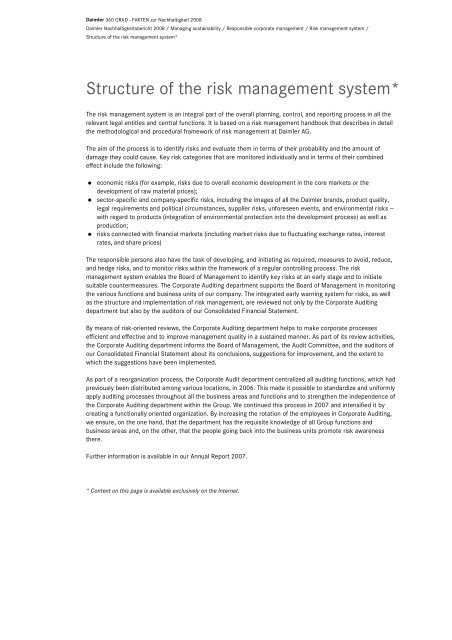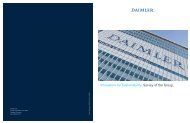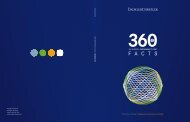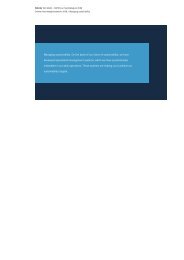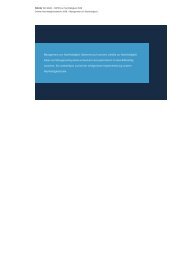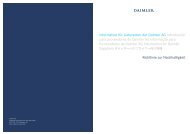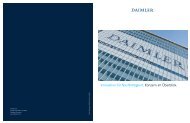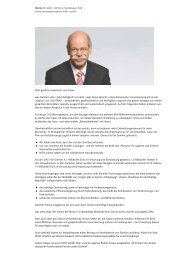Dear readers, This report describes what Daimler means by ...
Dear readers, This report describes what Daimler means by ...
Dear readers, This report describes what Daimler means by ...
You also want an ePaper? Increase the reach of your titles
YUMPU automatically turns print PDFs into web optimized ePapers that Google loves.
<strong>Daimler</strong> 360 GRAD - FAKTEN zur Nachhaltigkeit 2008<br />
<strong>Daimler</strong> Nachhaltigkeitsbericht 2008 / Managing sustainability / Responsible corporate management / Risk management system /<br />
Structure of the risk management system*<br />
Structure of the risk management system*<br />
The risk management system is an integral part of the overall planning, control, and <strong>report</strong>ing process in all the<br />
relevant legal entities and central functions. It is based on a risk management handbook that <strong>describes</strong> in detail<br />
the methodological and procedural framework of risk management at <strong>Daimler</strong> AG.<br />
The aim of the process is to identify risks and evaluate them in terms of their probability and the amount of<br />
damage they could cause. Key risk categories that are monitored individually and in terms of their combined<br />
effect include the following:<br />
� economic risks (for example, risks due to overall economic development in the core markets or the<br />
development of raw material prices);<br />
� sector-specific and company-specific risks, including the images of all the <strong>Daimler</strong> brands, product quality,<br />
legal requirements and political circumstances, supplier risks, unforeseen events, and environmental risks —<br />
with regard to products (integration of environmental protection into the development process) as well as<br />
production;<br />
� risks connected with financial markets (including market risks due to fluctuating exchange rates, interest<br />
rates, and share prices)<br />
The responsible persons also have the task of developing, and initiating as required, measures to avoid, reduce,<br />
and hedge risks, and to monitor risks within the framework of a regular controlling process. The risk<br />
management system enables the Board of Management to identify key risks at an early stage and to initiate<br />
suitable countermeasures. The Corporate Auditing department supports the Board of Management in monitoring<br />
the various functions and business units of our company. The integrated early warning system for risks, as well<br />
as the structure and implementation of risk management, are reviewed not only <strong>by</strong> the Corporate Auditing<br />
department but also <strong>by</strong> the auditors of our Consolidated Financial Statement.<br />
By <strong>means</strong> of risk-oriented reviews, the Corporate Auditing department helps to make corporate processes<br />
efficient and effective and to improve management quality in a sustained manner. As part of its review activities,<br />
the Corporate Auditing department informs the Board of Management, the Audit Committee, and the auditors of<br />
our Consolidated Financial Statement about its conclusions, suggestions for improvement, and the extent to<br />
which the suggestions have been implemented.<br />
As part of a reorganization process, the Corporate Audit department centralized all auditing functions, which had<br />
previously been distributed among various locations, in 2006. <strong>This</strong> made it possible to standardize and uniformly<br />
apply auditing processes throughout all the business areas and functions and to strengthen the independence of<br />
the Corporate Auditing department within the Group. We continued this process in 2007 and intensified it <strong>by</strong><br />
creating a functionally oriented organization. By increasing the rotation of the employees in Corporate Auditing,<br />
we ensure, on the one hand, that the department has the requisite knowledge of all Group functions and<br />
business areas and, on the other, that the people going back into the business units promote risk awareness<br />
there.<br />
Further information is available in our Annual Report 2007.<br />
* Content on this page is available exclusively on the Internet.


